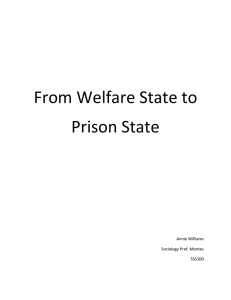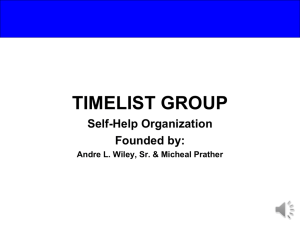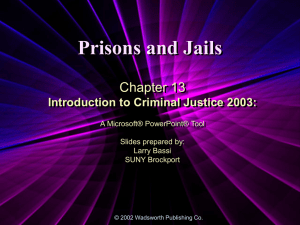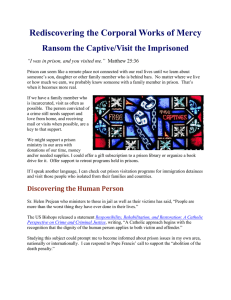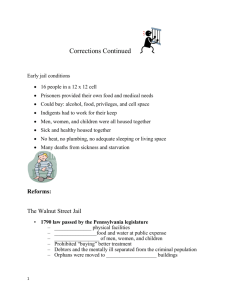Children Living in Jails!?
advertisement
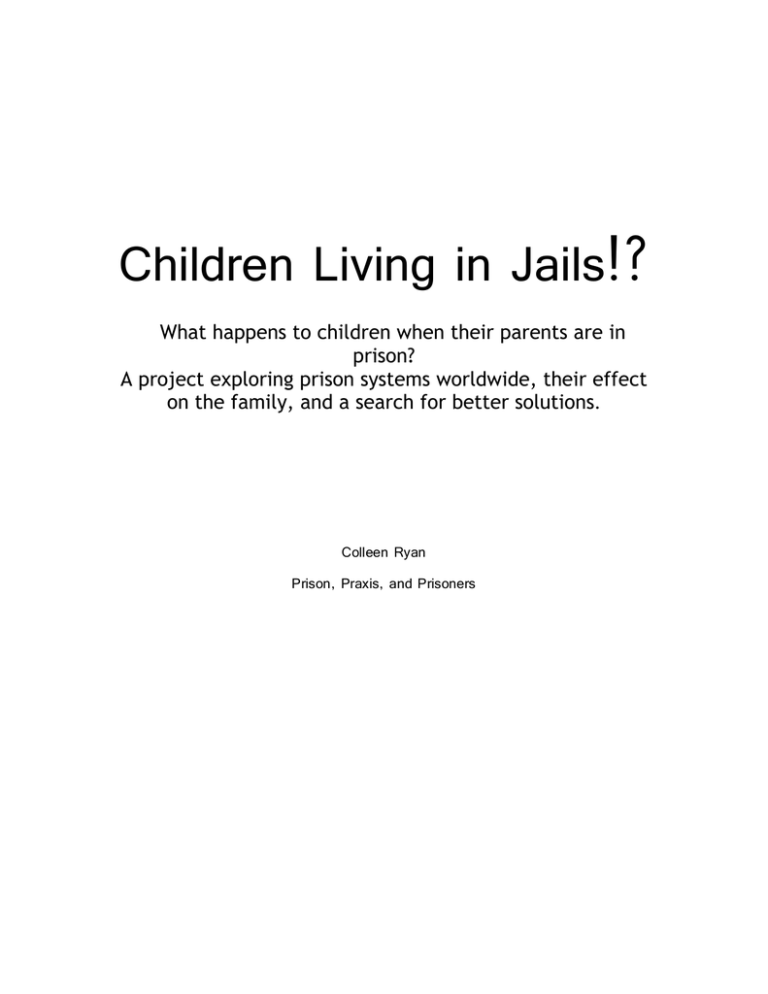
Children Living in Jails!? What happens to children when their parents are in prison? A project exploring prison systems worldwide, their effect on the family, and a search for better solutions. Colleen Ryan Prison, Praxis, and Prisoners Colleen Ryan Prison, Praxis, Prisoners Fall 2008 My praxis project has been a work in progress, continually changing throughout the semester as opportunities changed. All of the projects attempted dealt with mothers and their children in prisons. In the end, my actual service was done raising money for children living in a jail in Bolivia. Here is my journey, I hope you enjoy it! September 23, 2008: While at lunch with Jamie Williams and other Campus minster members I mentioned the class and our project. They gave me so many ideas of possible projects related to class. They discussed students at Vassar that visit actual prisons and that I should try to connect with them. Also, on the issue of women and prison which was my main interest, Jamie suggested a local poet, Sana Shabazz. She did prison ministry but also compiled accounts of women prisoners into a work entitled, Why Women Cry. I left with many thoughts in my head and excited about what I could work out. October 1, 2008: I researched Sana Shabazz’s book and found her website. I emailed her inquiring if she was available to offer information. I thought it would be interesting to maybe get her to come to Marist and read some selected poetry as an entertaining way of informing the Marist community about the issues. However, attempts to reach her produced no results. Below is a picture of her book, some information about it, and an excerpt from it. Sana Shabazz created her own productions in order to produce this work. On her myspace page, there is an explanation: "Why Cry Productions" is a production company formed by Sana Shabazz to highlight and enhance the works of women and their related issues. Its first order of business is the publication of "Why Women Cry...A Compilation of Stories, Poems and Positive Responses for the Cleansing of the Eyes and the Soul." http://profile.myspace.com/index.cfm?fuseaction=user.viewprofile&friendid=252302985 WHY WOMEN CRY...? [Excerpt] We cry because our toe hurts, We cry because our friends hurt, We cry because our hearts hurt by the ones we love the most, We cry because our loved one left and moved to the West Coast We cry because we're mensing and our hormones are in charge We cry because our butt is small--or is it way too large??? We cry because our parents tried to tell us what they knew We cry because we didn't listen, now life tells us what to do. We cry because we're angry, upset or in despair We cry because we don't know why & sometimes we don't care We cry because God says we can-He put those feelings there Although I was unable to get a copy of this work, I wish to find a copy in the future to read more of these poems about issues facing women in situations we learned about in class. October 9, 2008: In class we began to brainstorm praxis project ideas. We discussed an interest in entering Beacon’s women’s prison. Carola and I both expressed an interest in running a retreat, specifically a dance retreat. Carola knew someone in charge at the prison and contacted her to see about volunteering. October 10, 2008: I was leading a yoga retreat for campus ministry and while planning decided to do research on a dance retreat in case the retreat at Beacon worked out. I looked into other dance retreat groups to try and get information. I sent an email to the founder of a group called prayer in motion, but received no response. http://www.prayer-in-motion.com/ October 14, 2008 In class, we learned that we would not be able to get into Beacon to volunteer. Rules had changed and we would not be allowed in October 15, 2008 At my brother’s soccer game at Arlington High School I was asking my parents if they had any ideas for projects. My mom had recently talked with a family friend who worked at Taconic Correctional Facility In Westchester NY. They had a program for infants to stay with their mothers. I was really interested and decided I should try and contact them for more information. October 22, 2008 My brother sent me Mr. Purdy’s email address so I could ask about volunteering at Taconic’s program. (Included in the back of the journal is the email sent to Mr. Purdy). Mr. Purdy wrote me back that same night with contact information. He explained the facility and told me who to contact. (In back of journal is also the email from Mr. Purdy) October 23, 2008 I did some research on Mothers in prison in America and also the Hour Children program at Taconic Correctional Facility. At Taconic Correctional Facility in Westchester NY the facility is known for being one of only two prisons in the state that offer on-site nursery care for selected inmates and their infants. They believe it to be a valuable bonding program that has helped reduce recidivism. The program started in 1990 and grew out of the program at Bedford Hills. At Taconic there is space for sixteen inmates and their babies. The program is specifically designed for mothers diagnosed with alcohol and substance abuse problems. The inmates are allowed to keep their babies for 12 months and possibly up to eighteen months if it is possible they will be released from prison at that time. Inmates in prison longer than 18 months must give up their child to other forms of care. At the nursery, inmates stay with their babies in single rooms. At Taconic they stay together full time for two weeks. After this period the mother goes to programming during the day while the infant goes to a nursery run by Hour Children, an outside agency. They are then reunited when the mothers are done with programming. There are many benefits that have come out of this program. Studies show that inmates with strong family ties return to prison at lower rates than those without strong ties. Inmates enrolled in the nursery have lower incidence of disciplinary problems. Also, many of the inmates did not have good home lives growing up. Through training at the facility, they learn parenting skills. The program also benefits the infants. It is beneficial for an infant to bond with its mother at a young age. Also, living in a communal group setting is good for development of social skills. For this program, there are pediatricians on call 24 hours a day. Also, the program is helped by about 275 volunteers from the local community. (Taconic correctional website: www.correctionhistory.org, 10/23/08). Outside volunteer visits an inmate with child living in the prison nursery. http://www.correctionhistory.org/html/chronicl/docs2day/taconic.html This research made me think more about the issue of mothers in prisons. Before this class I did not know the majority of those incarcerated were in prison based on nonviolent usually drug related offenses. I did not know about conspiracy charges where usually women, wives, sisters, girlfriends etc were serving time because they would not give information, or they did not know the right information about loved ones' involvement. In the last ten years the number of women imprisoned is three times the amount of past years. Seventy five percent of these women have children, and six percent go to prison pregnant (www.its.org/whentheboughbreaks/mother.html). The real questions develop when these women are imprisoned; what happens to their kids? Often, there is nowhere for them to go, and they end up in foster care, with extended family, or other placements within the state. What about infants? Women who enter prison pregnant and then their children are taken from them at birth, what impact does this have? The first few months are important for a mother and child to spend together to develop their relationship. Related to this issue was a documentary we later watched in class. It was about women in India and how they are able to keep children up until age five in prison. Although you don’t want the children to feel punished, maybe we should set our system up differently. Learning about mothers in prison and their children, really touched me. There are so many factors involved, and so much opportunity for growth. ** This day was also the first day I placed a call to Kathaleen Linares and the Hour Children Program October 24, 2008-November 5, 2008 Every other week day in this period, a call was placed from me to Mrs. Linares and she would call me back. However, somehow, we missed talking directly for that long. Finally Mrs. Linares left a message with her email and told me to let her know my availability. I sent her an email on November 5th (At end of journal is a copy of the email) November 9, 2008 With no response heard from Mrs. Linares on Volunteering, I contacted Mr. Purdy one more time asking if there was a better way to reach her.(email is included in back) November 13, 2008 I tried calling Mrs. Linares one more time, and still did not talk to her directly. They must be really busy! I had already decided I wanted to help Alanna with her work raising money to provide children living in jails with medical supplies and support because it seemed like a great cause. As my plans to volunteer with the Hour Children Program appeared to fall through, I took a more active role in Alanna’s project. November 14, 2008 I did some research on children living in jails: The organization is Child Family Health International: The organization is designed to help more than 80 children under six years old who live with their mothers in a jail in La Paz. Their current needs include medical support and materials, personnel transportation costs and a computer to manage their project. With modest means, they seem to do a lot of good. www.cfhi.org I found this quote about the situation in Bolivia and in La Paz, the area we will be sponsoring. I found it interesting: Over a thousand children across Bolivia live in jails accompanying their parents while they serve sentences. Most are under the age of six, but many stay beyond that age, having no other place to go and no one outside to care for them. Many of the children were actually born in jail and so the life in there is the only life they know of. It is by no means ideal; indeed many aspects of such an existence are frightening and disturbing, but once you enter their world you realize that it is not like anything you could imagine without seeing and experiencing it with them… http://www.cfhi.org/web/fckeditor/uploaded/File/TaniaCorreareportLaPazSept07.pdf ( I really like this tag line on their website!) http://www.cfhi.org/web/index.php/program/viewdonatable/id/19 November 17, 2008 We had some speakers come to class recently and, since, I have been thinking about many issues related to class. It really interested me when Crystal, as well as Fred and Alice Bunnell came to visit and speak to our class. Crystal had served time in jail and in a way it was a wakeup call for her. She like many had enjoyed the high standard of living the drug industry provided her, she made mistakes, young. Now that she is out, she is trying her best not to violate parole, to work, and to provide for herself and if she can her daughter. However, the rules are so strict, and no one in government really seems to make it easier. Crystal explained the bureaucracy and how the system makes it hard for her to move on, requiring paper work that is difficult to obtain. She did the time, why should she pay the rest of her life by spending it trying to simply get back on her feet. Listening to her story, I was frustrated with the system, and wanted to help. One point of hope was listening to Alice and Fred Bunnell. They are volunteers with an organization called I CARE. They become mentors to those fighting reentry. (I am hoping to attend a Family Partnership meeting on December 15th. This meeting deals with those recently released, and those supporting them, also with aspects of the local community. It would be really interesting to see how the system is directly affecting this immediate area, also to see how issues from class are trying to be resolved. Another issue that struck me is one of restorative justice. In my opinion, when children or teens are committing crimes, they do not so much need to be jailed, as to be helped and supported in a way they need. I believe that people are inherently good and when someone commits a crime, especially a youth, it is a sign that something else is wrong. The system should be changed so that restorative justice programs can handle punishments rather than serving jail time. Youths should be able to volunteer and work to learn from mistakes instead of just serving time and wasting life. My older sister, currently in grad school for social work in NYC, spent a summer working with a restorative justice program in Troy, New York. She talked about her experience and spurred my interest in the subject. Through research I learned about something called a Community Accountability Board (CAB). This basically is an alternative sentencing program for non violent, first time offenders. Instead of court, the offender reports to a group of local community leaders. They are volunteers and together they agree on an alternative sentence for the offense. Usually community service and academic achievement are a part of the sentence. (www.albanycountyda.com/initiatives/CAB.html). When I read this, it really applied to our class. If we know what works, why are we not doing it? This CAB system seems like such a better way of handling things. Why is this not implemented in more places? I thought it related to mothers in prison not only because children in prison are more likely to go to prison themselves, but also because it is a program trying to get at the root of the real crime problem which often is related to poverty or lack of opportunity, issues that can be changed. Also, it seems like a more innovative way to handle problems, which I feel should also be applied into making policies benefiting children whose parents are in prison as well. November 20, 2008 After class I met with some of the other girls planning on helping with the project for children living in jails in Bolivia. We decided to do as many bake sales as possible. A bake sale before Thanksgiving break was too rushed, so we decided to plan them afterward. November 26, 2008 I decided to place one last call with Mrs. Linares, but again not direct contact December 1, 2008 Mrs. Linares called me back; I missed the call as I was at practice as usual. However this time she left a message for me to call a certain number on Thursday December 4, 2008. I also did some research today on children living in jails so that I could create flyers to hand out at the bake sales.(the flyers I created are attached in the back of the journal) According to www.savethechildren.org, I learned that there are about 1500 children living in jails in Bolivia. In La Paz specifically, there are about 90. I cannot even imagine this lifestyle. Yet most sources seem to be positive on the subject reflecting the idea that life inside this jail is better than the alternative. While not the ideal place for children to grow up, it is better than the alternative. In Bolivian jails, families live together in communal settings, preschools are provided and older children can leave to go to school. In San Pedro Prison in La Paz, there are even computers and technology classes for the children (savethechildren.org/countries/latin-america-caribbean) I I also learned that there are approximately 226 children living in prisons in Afghanistan. Poverty and safety are the two main motivations to keep children with their mothers. In prison, aid groups provide children with education and medical treatment not received by the average Afghan child. (www.clevland.com/world/2008/08/afghan) Children also live in jails in India. Hyderabad Jail in India is home to 160 women and 15 children. The women are mostly from poor backgrounds, life here may be better than at home: “Children in India can live with their imprisoned mothers until they are five years old, and in many cases receive better education, diet and healthcare than they would get at home.”(http://news.bbc.co.uk/2/hi/south_asia/4354712.stm) December 2, 2008 The girls working on raising money for children living in jails in Bolivia met and decided on definite dates for the bake sales: Friday December 5th and Friday December 12th. December 4, 2008 I called three times before finally being able to get a hold of Mrs. Linares. We talked briefly, she seemed really busy. She said I would be most useful helping babysit in the nursery Monday and Tuesday nights after 6pm. She wanted me to travel to Beacon CF because the need for volunteers was there. However, before I could do anything, she has to mail me volunteer forms. I am going to still try to volunteer, but am not sure if it will work out. After all of this effort I feel like I should try even if it is in a month or so, but I will see based on my schedule. If anything, I learned a lot about a great program and gained contact information for myself or others to volunteer there if there is interest. December 5, 2008 I made a few batches of muffins, printed out the flyers I had made earlier in the week and headed to set up for the bake sale. I sat at the table from 11:30 until 1:45. It was a very interesting experience. We had information flyers and posters explaining our cause, still, most people walking by asked what we were doing. It was fun telling people about the program. Most students and adults seemed shocked that children live in jails. I guess it is an interesting title. The generosity of the Marist community was surprising. I had worked many tables for campus ministry prior to this event, asking for donations and such, but students usually rushed by, ignoring the table. Maybe because this was something thought provoking and different, but many stopped. A few without money took our flyers. Most bought something or made a donation. Some even specifically stopped at the ATM in Donnelly just to make a donation. It was great to see such kind hearts. I was actually surprised. December 8, 2008 We will be having at least one more bake sale on December 12, 2008. This week, I am attempting to contact my team, campus ministry and other groups I am involved in to try and gain more support for the project. (Still no volunteer forms from Hour Children, so not sure what is happening with that). . What happens to the children when their mothers are in Prison? - 3 times the number of women have been imprisoned in the last ten years, due to mandatory-sentencing laws for drug offenses -75% of these women have children -6% of these women enter prison pregnant and are separated form their child immediately after birth -This effects many families in our nation and yet “There is no specific public policy nor routine process to coordinate what happens to the children, even immediately after childbirth”(www.its.org) What can be done…? There are some promising programs that should be promoted: Taconic Correctional Facility in Westchester NY the facility is known for being one of only two prisons in the state that offer on-site nursery care for selected inmates and their infants. They believe it to be a valuable bonding program that has helped reduce recidivism. The program is specifically designed for mothers diagnosed with alcohol and substance abuse problems. The inmates are allowed to keep their babies for 12 months, and possibly up to eighteen months if it is possible they will be release from prison at that time. There are many benefits that have come out of this program: Studies show that inmates with strong family ties return to prison at lower rates than those without strong ties. Inmates enrolled in the nursery have lower incidence of disciplinary problems. Also, many of the inmates did not have good home lives growing up. Through training at the facility, they learn parenting skills. The program also benefits the infants. It is beneficial for the infant to bond with its mother at a young age. Also, living in a communal group setting is good for development of social skills. For this program, there are pediatricians on call 24 hours a day. Also, the program is helped by about 275 volunteers form the local community. For more information on this program visit the Taconic correctional website: www.correctionhistory.org, Children living in jails?!? Although it may seem barbaric at first, for many around the world, it is better than the alternative… Poverty, unsafe conditions, on their own… Over a thousand children across Bolivia live in jails accompanying their parents while they serve sentences. Most are under the age of six, but many stay beyond that age, having no other place to go and no one outside to care for them. Many of the children were actually born in jail and so the life in there is the August-September 2007 only life they know of. It is by no means ideal; indeed many aspects of such an existence are frightening and disturbing, but once you enter their world you realize that it is not like anything you could imagine without seeing and experiencing it with them… http://www.cfhi.org/web/fckeditor/uploaded/File/TaniaCorrearep ortLaPazSept07.pdf Want to Help?? -BUY a Baked good, donate money, donate medical supplies: unopened bottles of children's chewable or liquid Tylenol (or any other children's chewable or liquid pain relieving medication) rubbing alcohol, hydrogen peroxide and bandages. http://www.cfhi.org/web/fckeditor/uploaded/File/TaniaCorreareportLaPa zSept07.pd ,and visit website for more information about the organization! -According to savethechildren.org, about 1,500 children are living in Bolivian jails. While not the ideal place for children to grow up, it is better than the alternative. In Bolivian jails, families live together in communal settings, preschools are provided and older children can leave to go to school. In San Pedro Prison in La Paz, there are even computers and technology classes for the children.(savethechildren.org/coutrie s/latin-america-caribbean) -In Afghanistan there are approximately 226 children living in prisons. Poverty and safety are the two main motivations to keep children with their mothers. In prison, aid groups provide children with education and medical treatment not received by the average afghan child. (www.clevland.com/world/2008/08/ afghan) - “Children in India can live with their imprisoned mothers until they are five years old, and in many cases receive better education, diet and healthcare than they would get at home.” Hyderabad Jail in India is home to 160 women and 15 children. The women are mostly from poor backgrounds, life here may be better than at home. (http://news.bbc.co.uk/2/hi/south_asia/4354 712.stm)


